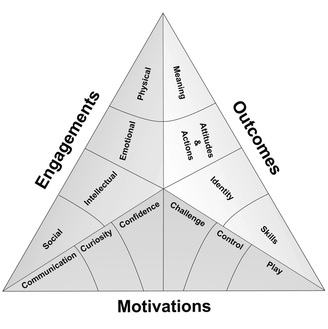Recently I finished reading What makes learning fun? Principles for the Design of Intrinsically Motivating Museum Exhibits by Deborah L. Perry. On one level, it’s a detailed case study of how visitors interact with one of the classic science centre exhibits, Coloured Shadows. On another level, it’s a characterisation of six key motivations that exhibits must satisfy in order to make learning inherently fun. Perry positions these in the context of Interpretive Activism, which she defines as:
. . .the process of advocating for and incorporating research-based, visitor-centered exhibit design principles and strategies that facilitate active visitor participation in the interpretive process. [Perry, 2012, p. 27]
A key element of interpretive activism is to conceive of exhibits as catalysts (for visitors own conversations and active learning) rather than simply conduits (for information):
Rather than lecturing and monopolising the language space . . . what if [museums] gave visitors the tools they need to engage in meaningful conversations with their companions? In other words, what if exhibits (including labels, but other components as well) were specifically designed to contribute to visitors’ conversations rather than interrupting them? [Perry, 2012, p.29]
Over a period of many years, Perry adjusted the design of the exhibit and accompanying interpretive information, testing the results each time with a range of visitors. It’s an interesting example of how certain exhibit features can act as interpretive red-herrings as people make sense of the exhibit.

Then, using features of this exhibit as an example, Perry explores the six motivations that sit at the base of the Selinda model of learning (shown below). They’re described in terms that will make the most sense in the context of hands-on exhibits, although the fundamental principles can be applied more broadly. I’ll summarise these briefly below (to the extent that I can summarise several book chapters in a single blog post!) . . .

- Communication: “Visitors are smarter than we think they are and know less than we think they do . . . [D]esign interpretation that gives visitors what they need to start a naturally occurring meaning-making process with their companions” (Perry, 2012, p. 94). People often visit museums in groups. Exhibits should acknowledge this, allowing for and encouraging social interaction and collaboration between visitors within social groups. Cater for a range of abilities (especially in exhibits targeted at families where there will be children at different ages). Use natural language in labels. Identify points where visitors may get stuck and offer guidance.
- Curiosity: Stimulate perceptual and intellectual curiosity. Pique interest by leaving some things unsaid – while too little information can be frustrating, if things are too obvious then curiosity can wane.
- Confidence: visitors will be motivated to learn in situations they feel “safe and smart”. (ibid, p. 118). Feedback should come early and come often. Success breeds a feeling of success and exhibits should guide the visitor through a “series of minisuccesses” (ibid, p. 131).
- Challenge: confidence and competence needs to be balanced with an appropriate level of uncertainty and challenge. Ensure visitors are clear what is expected of them, but don’t suggest that success will be automatic – visitors will not feel challenged if they can just go through the motions and be successful anyway.
- Control: the need for us to have control over our environment is an important facet of the psychology of visitor experiences. Visitors will feel in control when they have appropriate choices and the power to influence what happens in the environment.
- Play: play and the ability to engage the imagination is an essential ingredient of free-choice learning. ” . . . visitors who have the most satisfying and enjoyable experiences are those who feel the most playful – playful with actions yes, but also playful with ideas, playful with thoughts, playful all over” (ibid, p. 171).
Perry, D. (2012). What Makes Learning Fun? Principles for the Design of Intrinsically Motivating Museum Exhibits. Lanham, MD: AltaMira Press.

One Reply to “Interpretive Activism”